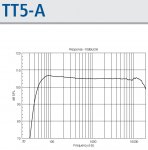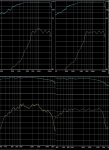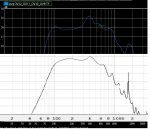Re: New DIY Mid High
I think I could write a 20 page paper on what the correct frequency response alignment should be; and I don’t think it’s as simple as most people think.
For example, cinema has the X-curve, and live sound engineers use microphones that typically have a 5dB presence peak between typically 4 KHZ and 10 KHz. They also have a LF proximity boost which varies from about -5dB to+10 dB depending on the distance you are away from the microphone.
So why, why do we have an X curve; although you may not agree with it or think it’s appropriate for live sound, which it’s not, someone felt it was so important that they put it into a standard, why(?), and why do we like microphones that are not flat. If you are going to argue that a speaker should have a flat frequency response, why not the same for the microphone?
I have always found it interesting when you mix a live concert that it’s often difficult to get the vocals to stand out, they are often lost in the mix but when you play a recording back on your studio monitors, there they are as clear as a bell, and probably louder than you would like. Why?
I think there are a several things that affect how we align our speakers, the psychoacoustics effects in the room including the first 30ms of arrivals, as well as the overall quality of the speaker.
If the speaker is particularly good in terms of its amplitude, phase, distortion and time domain issues you can easily separate all the instruments in the mix, you don’t have to push the vocals or make them a little bright, they will sit nicely and clearly in the mix at the correct level. There is no need to boost the HF to add clarity. It’s so easy to mix on that type of speaker; you don’t spend half the night chasing your tail feeling like you have never got the mix quite right.
I designed this speaker with that in mind. The 12 inch mid-range operates only in its piston range with the small volume between the driver and horn throat aching as a lowpass filter. Only between about 80Hz and150 Hz is there a compromise where there is assistance from the port.
I designed it to be used with DSP correction. A “perfect speaker” operating into a fixed solid angle of radiation with a rigid cone will not have a flat frequency response. Cone speakers use narrowing directivity with increasing frequency and cone breakup to extend their HF response.
Providing you are correcting things that are linear it’s perfectly fine to use DSP correction. In this case the lumps and bumps that are defined in Hornresp below about 800Hz.
The use of a two way coaxial high frequency driver also means that the VHF is not defined by diaphragm break up modes and the 4594 can go low enough to reach down to the piston range of the 12 inch drivers.
I voiced the speaker to sound as natural and realistic as I could, so that my voice on the measurement mic (Earthworks M30) sounded EXACTY like me. I got people to listen to me and then turn away and talk into the measurement mic and ask them if the speaker sounded exactly like me as a check. I played tracks with male and female voices and natural instruments. I voiced it with typical microphones:- SM58, B58, KSM9 & KSM105. I took my best guess, but it’s not hard to change it to flat or whatever, even a death metal ice pick in the forehead above 3K setting.
Interestingly, I seem to have voiced it similar to RCF’s newTT2a and TT5a. (I can’t find any plots for d&b and L-acoustic products)
I think I could write a 20 page paper on what the correct frequency response alignment should be; and I don’t think it’s as simple as most people think.
For example, cinema has the X-curve, and live sound engineers use microphones that typically have a 5dB presence peak between typically 4 KHZ and 10 KHz. They also have a LF proximity boost which varies from about -5dB to+10 dB depending on the distance you are away from the microphone.
So why, why do we have an X curve; although you may not agree with it or think it’s appropriate for live sound, which it’s not, someone felt it was so important that they put it into a standard, why(?), and why do we like microphones that are not flat. If you are going to argue that a speaker should have a flat frequency response, why not the same for the microphone?
I have always found it interesting when you mix a live concert that it’s often difficult to get the vocals to stand out, they are often lost in the mix but when you play a recording back on your studio monitors, there they are as clear as a bell, and probably louder than you would like. Why?
I think there are a several things that affect how we align our speakers, the psychoacoustics effects in the room including the first 30ms of arrivals, as well as the overall quality of the speaker.
If the speaker is particularly good in terms of its amplitude, phase, distortion and time domain issues you can easily separate all the instruments in the mix, you don’t have to push the vocals or make them a little bright, they will sit nicely and clearly in the mix at the correct level. There is no need to boost the HF to add clarity. It’s so easy to mix on that type of speaker; you don’t spend half the night chasing your tail feeling like you have never got the mix quite right.
I designed this speaker with that in mind. The 12 inch mid-range operates only in its piston range with the small volume between the driver and horn throat aching as a lowpass filter. Only between about 80Hz and150 Hz is there a compromise where there is assistance from the port.
I designed it to be used with DSP correction. A “perfect speaker” operating into a fixed solid angle of radiation with a rigid cone will not have a flat frequency response. Cone speakers use narrowing directivity with increasing frequency and cone breakup to extend their HF response.
Providing you are correcting things that are linear it’s perfectly fine to use DSP correction. In this case the lumps and bumps that are defined in Hornresp below about 800Hz.
The use of a two way coaxial high frequency driver also means that the VHF is not defined by diaphragm break up modes and the 4594 can go low enough to reach down to the piston range of the 12 inch drivers.
I voiced the speaker to sound as natural and realistic as I could, so that my voice on the measurement mic (Earthworks M30) sounded EXACTY like me. I got people to listen to me and then turn away and talk into the measurement mic and ask them if the speaker sounded exactly like me as a check. I played tracks with male and female voices and natural instruments. I voiced it with typical microphones:- SM58, B58, KSM9 & KSM105. I took my best guess, but it’s not hard to change it to flat or whatever, even a death metal ice pick in the forehead above 3K setting.
Interestingly, I seem to have voiced it similar to RCF’s newTT2a and TT5a. (I can’t find any plots for d&b and L-acoustic products)
Attachments
Last edited:





